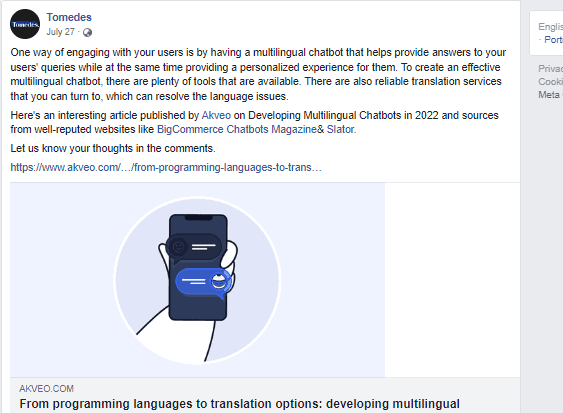There are around 4.59 billion social media users around the world today. That is roughly 58% of the world’s population. Those numbers mean a lot of things but as a business owner, it should mean to you that you must seriously think about how social media can be a part of your overall marketing strategy. Now, when you are thinking about your social media strategy, you must remember that only 25.9% of internet users speak English. If you want to reach out to the rest of the world, then you must translate your social media content into other languages too. You’ll need the translation of social media posts.
This article will look at some best practices when it comes to social media translation and how you can implement it for your own marketing.
Why Translate Social Media Posts?
Many companies translate their social media content now. It’s a practice that is becoming more and more common. Unfortunately, many are just following that trend without understanding the logic behind the move.
The truth is that there are several reasons why you must translate social media posts. We’ll go through those reasons one by one.

Wider Audience
The most obvious reason for translating social media content is the wider audience that you can get. As mentioned, English speakers make up only a quarter of internet users. If you just stick to English, then what about the rest of the world? That should be enough if your business only targets an English-speaking audience but if you would like to expand then you should have your social media content translated.
It Builds Trust
Consumers trust a company or a brand more when they can find the information that they need in their own language. This can be explained by the Trust theory. This theory basically states that trying to understand how others will behave is such a daunting task that people shirk away from those whom they don’t trust because they don’t understand them.
What’s the main way that people can understand each other? It is through language. If people can’t understand what you are saying they would not trust you. Speaking the same language as them makes it easier for them to predict how you will behave and that reassures them.
That’s the science behind the fact that consumers like it when they can get information in their own language.
Makes Your Content More Shareable
Translating your content also makes it easier for your content to be shared by others. You have more people helping you boost your marketing when that happens. When your followers on social media start sharing your content they become part of your marketing team as well.
These are just some of the benefits that you can derive from having your social media content translated into multiple languages.
Challenges of Translating Social Media Posts
Translating social media content is not an easy undertaking, especially if you need to target multiple languages. Remember, it’s not just the language that must be localized but other aspects of the post as well. Things like culture, figures of speech, and images used for social media posts must be considered too.
Other challenges in translating social media posts can be inherent in the language. Take Hebrew translations for example as discovered through a study conducted at the Ben Gurion University of the Negev. The modern Hebrew language has certain qualities that make translation into American English difficult. The Hebrew language has a very complex pronoun system that can be inflected for person, number, and gender. Masculine forms of pronouns can be used generically and gender-specific while feminine forms are only gender-specific.
Details like those found in the study make English-to-Hebrew translations even more complex when compared to other language pairs. Another major challenge in translating social media posts is finding a specialist who can do it well. It is not easy to look for English-to-Hebrew translation specialists, who are also familiar with the niche or the industries involved. As mentioned, this goes beyond simple language translation. It takes an understanding of the culture and society of the target language and also a grasp of how social media works in general.
What happens when your content is not going to work when translated into the target language? What do you do when there is no equivalent figure of speech?
Those are just some of the proof that translating social media content is not for everyone.
Tips for Translating on Social Media
We’ve discussed the benefits of translating your social media posts. We have also touched upon the challenges of social media translation. Now, it’s time to explore the best practices that you can follow when doing social media translations.

Know Your Audience
Knowing your audience is one of those things that is easier said than done. How can you get to know the people connecting to you on social media?
For starters, you can get to know the people that you have connected with already. This includes your existing customers and social media followers. You can get their data like age, interests, gender, and income (although you must be discreet with how you ask this).
You can use analytical tools to get the information that you need. You can analyze the data then and gain insight as to who your audience is. It is far more difficult to get information about those who have not bought from you or have not followed your social media so far and yet are part of your audience.
This is where you can use a lead magnet. If you have not used a lead magnet then you are missing out on a great opportunity to gather information. A lead magnet is something that you can offer to your audience in exchange for their information. The usual offer is a newsletter or an eBook but it doesn’t have to be written content. It can be anything as long as your audience will feel that it has value.
Remember, your goal is to know your audience. You need to get as much information about them as you can. Your audience will be spread out across multiple markets. What you learn about them will be used in creating and translating your social media posts.
Create Content That Is Easy to Translate and Localize
When you are creating your main content, you should consider the fact that it will be translated. It will be easier to localize your content that way.
The usual problem is that social media content is initially written for the main audience first and then the translators will have to worry about localizing it for other markets later on.
For example, if you create content about the 4th of July celebration because your main audience is American, do you think that will translate well? How will that message come across to your other audience?
So, when you think about the social media posts you want to post, consider things that can be universal. Think about messages that everyone will understand and relate to.
Another thing to think about is the length of the posts. Sometimes the text will be extended or shortened when posts are translated. That’s another thing to think about.
When you are writing your posts, try to use the simplest language possible. There are tools now that you can use to check on the Grade level which can understand your writing. When you use simple words, you’re making things easier for the translators who will work on your content.
Another thing that you can do to help the translators is to be consistent with the terms you use. That will help the translators too so they don’t have to figure out how to translate a new term all the time.
Does that sound too much? When you’re serious about translating your social media posts, you really have to think about these things.
Localized Hashtags
A hashtag is a metadata that is included in social media content that is preceded by the # symbol. It is used on social media platforms for cross-referencing, allowing users to connect their content to others that have a similar theme.
Because of the nature of hashtags, you can use them to localize your social media post. You can use the hashtag that identifies the cities you want to target with one post and then do the same for the translations.
Get Professional Help
Localization is not an easy task. It’s not just about translating social media posts from one language to another. Various aspects of the new target audience must be considered. Because of that, you need someone who is more than a translator. You need someone who is an expert at localization.
For example, if your original posts are in English and intended for Americans and you need to translate them to Thai, then you need more than just an English and Thai speaker. You need someone who is familiar with American and Thai culture at the same time.
You don’t want to post content that can be offensive to your target audience. The Thai for example are very sensitive about their Royal family. It is a crime to say anything against their king. So posts that might denigrate royalty, in general, might be seen there as offensive even though it’s ok America.
Localization experts know those small details about the culture of the target audience. They can change the social media content to make it more appealing to the new market.
Careful with Automation
Automation can be a great help when it comes to social media. It is possible now to have your posts translated through online tools. However, you must be careful with using these types of tools when translating your posts. While translation tools are very advanced now and there is no guarantee that they can translate the content correctly.
You will need to check the translation output but if you don’t speak the target language, then how can you do that? We will go back again to the necessity of getting professional help for your social media translations.
Localize Emojis and Images

Again, it’s not just the language that has to be localized but the other aspects of the posts as well. Something you might forget is the use of emojis.
Not all companies use emojis on their social media posts. If yours do, then it can help in adding emotion and urgency to the post. However, you should be aware that emojis are not universal. Those small images might mean something else in a different culture.
For example, the fist emoji usually denotes a fist bump but in other cultures, it could signify a punching gesture. Small things like that can make a lot of difference.
These are just some of the tips that you can keep in mind when you are translating your social media content. It’s always important to remember that you will be speaking to different markets and audiences. What is acceptable to one set of audiences is not necessarily going to be ok with others.
One other important point that you should remember when you are trying to reach different markets through social media. You need to create a distinct social media account for each market that you want to reach.
If you want to reach Spanish speakers then you should create a separate Spanish account. That should be the same thing for any major language which you want to use for your social media marketing.
By having separate accounts, you can address the needs and nuances of each audience on their own. You can still translate your content, but you will also have the freedom to create content that is made specifically for an audience.
That sounds like a lot of work and it is. However, it’s the best way for you to do multilingual social media marketing.
Make your social media campaign stand out by making multilingual. Just make sure that you translate the content in the right way. The tips we have outlined here should point you in the right direction.


